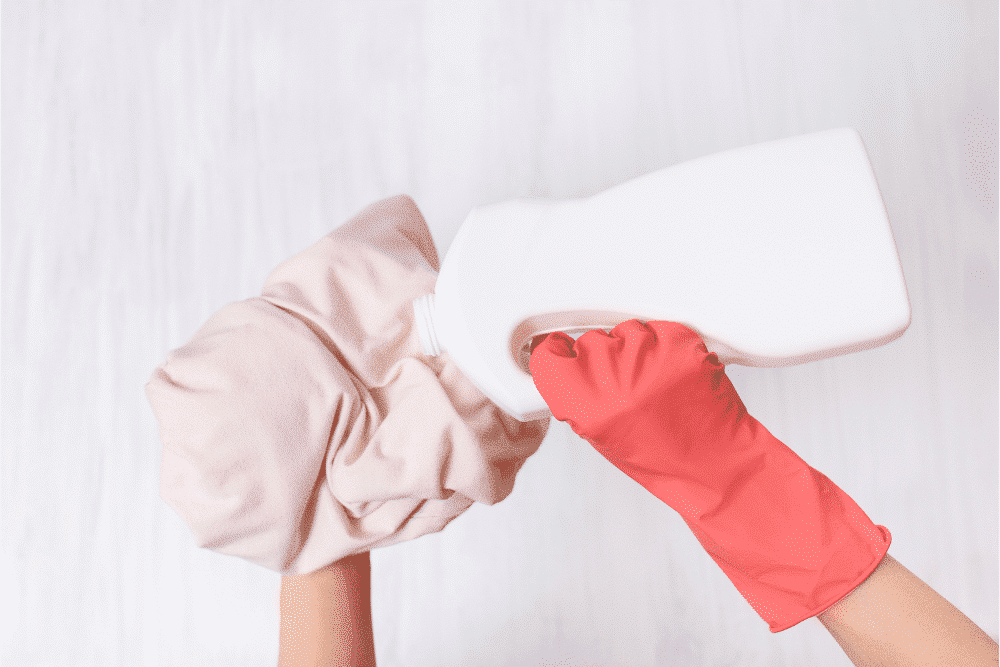For decades, liquid bleach (or sodium hypochlorite) has been synonymous with sanitizing and disinfecting – but what about using it around kids, pets and those with respiratory conditions like asthma and allergies? Here’s what you need to know about disinfecting with bleach, and how to use hypochlorous acid (HOCl) as an alternative that is safe on surfaces without rinsing, and still effective against bacteria and viruses.
Top 5 Things You Need to Know About Using Hypochlorous Acid As A Better Alternative To Bleach For Disinfecting
#1. Bleach is a strong chemical that must be handled with care.
Bleach is a registered disinfectant, which means that the Environmental Protection Agency has tested bleach and determined it kills 99.9% of the bacteria and viruses that it claims to within its designated dwell time. Unfortunately, products like bleach are now so commonplace that many people don’t understand the need to carefully follow the safety directions and treat liquid bleach as a potentially hazardous substance. Here are some tips to remember when using bleach:
- Read directions on the label and follow them closely, don’t assume you know. Dilution ratios, dwell times, and storage instructions could be different than you think. And you never want to combine bleach with other cleaning chemicals. An example is ammonia, where if combined with bleach, can cause chloramine gas, which can be deadly.
- Wear gloves when working with bleach and wash your hands afterward.
- Use in a very well ventilated area, as bleach fumes can trigger respiratory reactions. If you have asthma, avoid using it. Studies have linked use of liquid bleach to lung damage, citing that even infrequent use on a weekly basis could increase the risk of developing serious respiratory conditions like COPD.
- Bleach can be corrosive and can cause burns to skin and eye tissue as well as corrode surfaces like certain metals or stones, so be extremely careful about splashing and where you store it.
- Contact poison control if you or someone in your household ingests bleach or gets it in their eyes, nose or ears. Household cleaning products can be a major source of poisoning for children, so keep any products containing liquid bleach out of reach of children and pets.
#2. Hypochlorous Acid Disinfects As Well As Sodium Hypochlorite
Hypochlorous acid (HOCl), like liquid bleach, is listed as a disinfectant on EPA List N, the EPA’s list of disinfectants that are approved for use against SARS-CoV-2, the novel coronavirus, the cause of Covid-19. Hypochlorous acid is the active antimicrobial ingredient in several EPA-registered disinfectants & sanitizers because it kills 99.9% of viruses and bacteria.
#3. Hypochlorous Acid is used in all kinds of applications where safety matters
HOCl is used in all kinds of medical applications for the purpose of killing microorganisms and fighting infection and promoting healing, like veterinary medicine, ophthalmology, and even dermatology (right now it’s a superhero in the fight against “maskne!”).
#4. Hypochlorous Acid Is Certified Allergen-Free and Safe on Skin by Mayo Clinic
Hypochlorous acid is certified to be skin-safe and best for sensitive skin by SkinSafe, the Mayo Clinic’s allergy safety rating system for all types of product, from wound healing to eye care. That’s why it’s commonly used in products like wound healing.
#5. Hypochlorous Acid Does Not Need To Be Rinsed
Because it’s gentle on your skin and on surfaces without corroding or causing damage, there is no need to wear gloves or rinse the surface after disinfecting – even eating surfaces! Hypochlorous acid is created by combining the right concentrations of salt, vinegar and water at the right pH. Once electrolyzed, which is when an electrical current is applied to them, these simple household ingredients create hypochlorous acid.
Finding safer alternatives for more products
At Force of Nature, we’re committed to helping families find products that are safer for our planet and our littlest & furriest family members. Whether it’s dental floss, hand sanitizer, baby wipes, sunscreen, or just about anything else, we’ve got tips to help you choose safer products on our blog.




